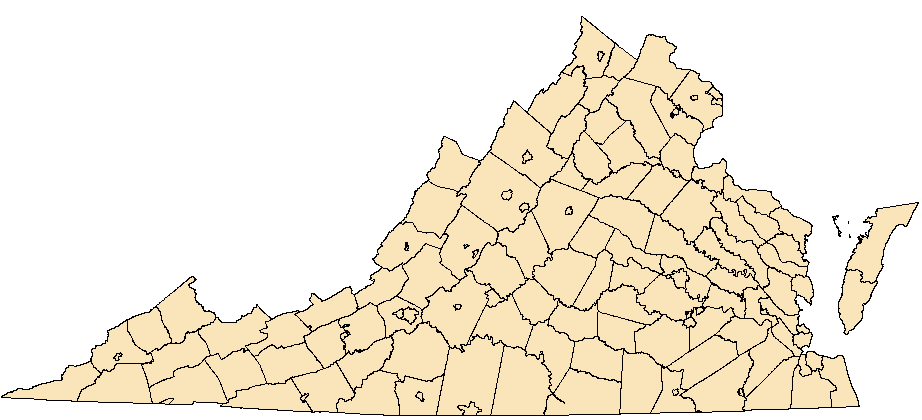Hesperia attalus slossonae (Skinner, 1890)
Dotted Skipper (= Seminole Skipper)
NatureServe Global Rank: G3G4T3
Virginia State Rank: SH
VA DGIF Tier: II
Federal Legal Status: None
Virginia Legal Status: None
Description: The Dotted Skipper is a medium sized skipper and shows a similar sexual dimorphism to many other Skipper species. The dorsal male has an orange patch covering much of the area around the black stigma and dark brown outer wing coloration. The female is mostly dark brown above with a small wrist bracelet and a line of spots running from this to the trailing edge of the wing. Atypical of female skippers, other spots exist on either side of the main line of spots/wrist bracelet. The hind wing for both sexes is mainly dark with some orange frosting and a variable line of orange dots. The ventral side of the hind wing is similar for both sexes in that there is a line of spots about 4/5 the length from the base, with the second and third dot disjunct toward the edge of the wing. There is another single spot near the center of the wing. The female base color is tan-brown with white dots, and the male has a slightly more orange hue with less obvious yellow spots.
Similar species: A few species are similar to the Dotted Skipper. The Crossline Skipper is similar based upon the ventral markings, but the spot are less distinct and are more lined up following the contour of the edge of the hind wing as opposed to the offset spots in the Dotted Skipper. The dorsal side of the male displays more orange than the Dotted Skipper; the dorsal side of the female does not exhibit spots on either side of the main line of spots that run from the wrist bracelet to the trailing edge of the front wing. It is also similar to the Northern Broken-Dash and Southern Broken-Dash. On either of these the spot line on the ventral hind wing has the second and third spot from the leading edge in line but elongated towards the base of the wing and not disjunct towards the edge of the wing.
North American Range: The Dotted Skipper is found in isolated populations from New Jersey south to Florida and along the northern Gulf of Mexico. One separate population occurs in northern Texas north to Nebraska.
VA Observations by Locality: Loudoun | Prince Edward | Roanoke




Flight season and broods: In most areas in their range, the skippers produce two broods between the months of May and September. It is suspected that the season is slightly longer with possibility of three broods in the Gulf region.
Habitat and Food Plants: This species specialized in xeric environments including pine barrens and sandhills. It prefers open pine forests with an understory that consists of various grass species including its host plant. The host plants of choice for the Dotted Skipper are Switchgrass (Panicum virgatum) and Fall Witchgrass (Leptoloma cognatum).
Behavior and Ecology: The Dotted Skipper adults nectar from Prickly Pear Cactus but prefer purple flowers such as Purple Coneflowers and Liatris species. Males and females often perch around stands of nectar plants and fly quickly between them while seeking food. The caterpillars over-winter as pupae in tubes at the base of host grass clumps.
Population trend and potential threats: Although once it may have been much more widespread, the Dotted Skipper occupies only a few isolated locations north of Florida. These few remaining populations are mostly secure but rely on the maintenance of the xeric, open pine forests in which they thrive.
Management practices: It has been noted that this skipper does not respond well to regulated burning in their habitat. Burns should be limited to ensure population success.
References: Cech, R. & G. Tudor. 2005. Butterflies of the East Coast. Pg 306. Princeton University Press.
Cook, W. (2006). Bug Guide. Hesperia attalus [Online]. Available: http://bugguide.net/node/view/89663 [2006, September 30].
Opler, P. A. 1992. A Field Guide to Eastern Butterflies. Peterson Field Guides
U.S. Geological Society. (2011). Butterflies and Moths of North America. Hesperia attalus slossonae[Online]. Available: http://butterfliesandmoths.org/species/hesperia-attalus [2011, November 29].
Virginia Department of Conservation and Recreation, Natural Heritage Program, 600 E. Main St., 24th Floor, Richmond, VA 23219
This atlas was compiled
by the VA Natural Heritage Program with funds provided by the VA Dept. of Game and Inland Fisheries through a state wildlife grant
from U.S. Fish and Wildlife Service
Questions/Comments? Check the contacts page |
Internet Privacy Policy Statement
Last Modified: Friday, 26 February 2021, 03:21:56 PM